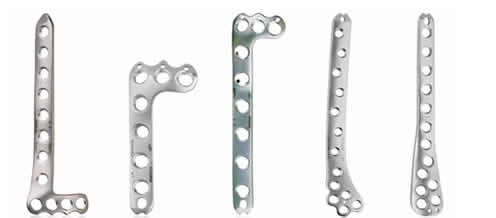
Product Information
The lower extremity portfolio offers the advantages of locked plating with the flexibility and benefits of traditional plating in one system. Utilizing both locking and non-locking screws, PERI-LOC offers a construct that resists angular (e.g. varus/valgus) collapse while simultaneously acting as an effective aid to fracture reduction. A simple and straightforward instrument set features one screwdriver, standardized drill bits, and color-coded instrumentation, making PERI-LOC efficient and easy to use.
- Anatomically contoured locking plates
- Unique locking screw hole that allows you to lag, lock and provide axial compression in a single hole
- Stainless steel implant system
- Radiolucent targeting systems: handles offset for clear imaging
Features of the Lateral Distal Femur Locked Plate
- Radiolucent targeter available for percutaneous technique 2
- Periarticular recesses to allow for easy placement of independent lag screws to assist with joint reduction
- Plate shaft designed with an anatomic bow
- Beveled tip to assist with submuscular insertion
- Available in 6, 8, 10, 13, 16 and 19 hole configurations (155-399mm)
Features of Proximal Femur Locked Plate
- Six points of multiplanar fixation for rotational stability
- Increased plate thickness in neck region to counteract varus stress throughout the healing process 1
- Plate shaft designed with an anatomic bow
- Radiolucent targeter available for percutaneous technique 2
- Compatible with the ACCORD* cable system to treat periprosthetic fractures
- Beveled tip to assist with submuscular insertion
- Available in 2, 4, 6, 9, 12, 15 and 18 hole configurations (99-396mm)
Download the Distal and Proximal Femur Sales Sheet for more information.
Features of the Lateral Proximal Tibia Locked Plate (sizes 3.5mm and 4.5mm)
- 3.5mm and 4.5mm Proximal Tibia Locking Plates
- May be percutaneously implanted using a radiolucent targeting system, allowing for preservation of blood supply
- The screw hole design allows for locking, non-locking and compression - gaining capabilities through the same hole
- Periarticular recesses which facilitate lag screw placement for joint surface reconstruction without compromising plate position
- Beveled tip to assist with submuscular insertion
Each screw hole in the 3.5mm Lateral Proximal Tibia Locking Plate will accept one of four different screws allowing customization of the screw configuration depending on the individual needs of the fracture:
- 3.5mm Locking Self-Tapping Cortex Screw
- 3.5mm Self-Tapping Cortex Screw (Non-Locking)
- 4.0mm Partially Threaded Cancellous Screw
- 4.0mm Fully Threaded Cancellous Screw
Each screw hole in the 4.5mm Lateral Proximal Tibia Locking Plate will accept one of four different screws allowing customization of the screw configuration depending on the individual needs of the fracture:
- 4.5mm Self-Tapping Cortex Screw (Non-Locking)
- 4.5mm Locking Self-Tapping Cortex Screw
- 5.7mm Cannulated Locking Screw
- 6.5mm Partially Threaded Cancellous Screw
Download the Proximal Tibia Sales Sheet for more information
Features of the Anterolateral Distal Tibia Locked Plate
- Helical twist of the plate shaft contours to the lateral tibia
- Beveled tip assists with submuscular insertion
- Distal periarticular recesses allow for easy placement of independent lag screws for reduction of articular surface
- Left/Right specific
- Available in 4,6,8,10 and 13 hole configurations (72-186mm)
- Each screw hole will accept one of four different screws allowing you to customize the screw configuration depending on the individual needs of the fracture:
- 3.5mm Locking Self-Tapping Cortex Screw
- 3.5mm Self-Tapping Cortex Screw (Non-Locking)
- 4.0mm Partially Threaded Cancellous Screw
- 4.0mm Fully Threaded Cancellous Screw
Download the Anterolateral Distal Tibia Sales Sheet for more information
Features of the Medial Distal Tibia Locked Plate
- Features a beveled tip proximally to allow easy percutaneous insertion
- Holes in the plate can be used for 1mm of compression or locking and it is anatomically contoured to match the distal tibia.
Surgical Techniques
Download Large Fragment Surgical Technique for:
- 4.5mm Proximal Humerus Locking Plate
- 4.5mm Lateral Distal Femur Locking Plate
- 4.5mm Lateral Proximal Tibia Locking Plate
Download the Small Fragment Surgical Technique for:
- 3.5mm Lateral Proximal Tibia Locking Plate
- 3.5mm Medial Distal Tibia Locking Plate
- 3.5mm Anterolateral Distal Tibia Locking Plate
- 3.5mm Calcaneus Locking Plate
- 4.5mm Lateral Distal Femur Locking Plate
- 4.5mm Lateral Proximal Tibia Locking Plate
- 3.5mm Lateral Proximal Tibia Locking Plate
- 3.5mm Medial Distal Tibia Locking Plate
References
1. Glassner PJ, Tejwani NC. Failure of Proximal Femoral Locking Compression Plate: A Case Series.Journal of Orthopedic Trauma. 2011;25:76-83.
2. Farouk O, Krettek C, Miclau T, Schandelmaier P, Tscherne H. Effects of Percutaneous and Conventional Plating Techniques on the Blood Supply to the Femur. Arch Ortho Trauma Surg. 1998; 117(8):438-41.


